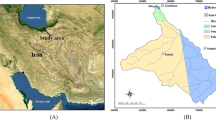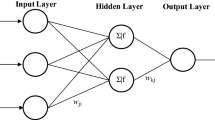Abstract
The artificial neural network (ANN) theory has been widely applied to practical applications in hydrology. Since watershed rainfall–runoff processes are nonlinear and exhibit spatial and temporal variability, the ANN model, which considers watershed nonlinear characteristics, can usually but not always obtain satisfactory simulation results. The training of an ANN network is based completely on the reliability of the available hydrologic records. The objective of this study was to provide deterministic insight into the limitations of storm runoff simulation when using ANN. Hydrologic records of 42 storm events from two watersheds in Taiwan were adopted for analysis. A deterministic runoff model was used to classify the hydrologic records into “usual” and “unusual” storm events. The analytical results show that the ANN model could provide good simulation results for “usual” storm events; however, its performance was poor when it was applied to “unusual” storm events because no consistent hydrologic characteristics could be extracted from the storm event records using ANN. The success of the ANN model in usual storm discharge simulations may be mainly due to the input vectors including the previous observed discharge. Moreover, the number of past periods of rainfall that were set as the input vectors of the ANN model was found to be highly correlated with the watershed time of concentration. It can be used to efficiently determine the ANN network structure instead of using iterative network training.
Similar content being viewed by others
References
Amorocho J (1967) The nonlinear prediction problem in the study of runoff cycle. Water Resour Res 3(3):861–880
Anmala J, Zhang B, Govindaraju RS (2000) Comparison of ANNs and empirical approaches for predicting watershed runoff. J Water Resour Plan Manage, ASCE 126(3):156–166
ASCE Task Committee (2000a) Artificial neural networks in hydrology. I: Preliminary concepts. J Hydrol Eng ASCE 5(2):115–123
ASCE Task Committee (2000b) Artificial neural networks in hydrology. II:Hydrologic applications. J Hydrol Eng ASCE 5(2):124–137
Caudill M (1987) Neural networks primer. Part I. AI expert:46–52
Chiu CL, Huang JT (1970) Nonlinear time-varying model of rainfall–runoff relation. Water Resour Res 6(1):1277–1286
Chow VT (1959) Open-channel hydraulics. McGraw-Hill, New York
Chow VT (1964) Handbook of applied hydrology. McGraw-Hill, New York
Dawson CW, Wilby R (1998) An artificial neural network approach to rainfall–runoff modeling. Hydrol Sci J 43(1):47–66
Ding JY (1974) Variable unit hydrograph. J Hydrol 22:53–69
Dooge JCI (1959) A general theory of the unit hydrograph. J Geophys Res 64(1):241–256
Engman ET (1986) Roughness coefficients for routing surface runoff. J Irrig Drain Eng ASCE 112(1):39–53
French MN, Krajewski WF, Cuykendall RR (1992) Rainfall forecasting in space and time using a neural network. J Hydrol 137:1–31
Haykin S (1994) Neural Networks: a comprehensive foundation. MacMillan, New York
Hopfield JJ (1982) Neural networks and physical system with emergent collective computational abilities. Proc Natl Acad Sci 79:2554–2558
Hsu K, Gupta HV, Sorooshian S (1995) Artificial neural network modeling of the rainfall–runoff process. Water Resour Res 31(10):2517–2530
Hydrologic Engineering Center (2000) Hydrologic modeling system HEC-HMS, Technical reference manual, U. S. Army Corps of Engineers.
Jain A, Indurthy SKVP (2003) Comparative analysis of event-based rainfall–runoff modeling techniques – deterministic, statistical, and artificial neural networks. J Hydrol Eng ASCE 8(2):93–98
Kumar DN, Raju KS, Sathish T (2004) River flow forecasting using recurrent neural networks. Water Resour Manag 18:143–161
Lee KT (1998) Generating design hydrographs by DEM assisted geomorphic runoff simulation: a case study. J Am Water Resour Assoc 34(2):375–384
Lee KT, Yen BC (1997) Geomorphology and kinematic-wave based hydrograph deviation. J Hydraul Eng ASCE 123(1):73–80
Lee KT, Chang C-H, Yang M-S, Yu W-S (2001) Reservoir attenuation of floods from ungauged basins. Hydrol Sci J 46(3):349–362
Lee KT, Chung Y-R, Lau C-C, Meng C-C, Chiang S (2006a) A windows-based inquiry system for design discharge based on geomorphic runoff modeling. Comput Geosci 32(2):203–211
Lee KT, Ho Y-H, Chyan Y-J (2006b) Bridge blockage and overbank flow simulations using HEC-RAS in the Keelung River during the 2001 Nari typhoon. J. Hydraul Eng, ASCE 132(3):319–323
Muleta MK, Nicklow JW (2004) Joint application of artificial neural networks and evolutionary algorithms to watershed management. Water Resour Manag 18:459–482
Minshall NE (1960) Predicting storm runoff on small experimental watersheds. J Hydraul Eng ASCE HY8:17–38
Nash JE (1957) The form of instantaneous unit hydrograph. Int’l Assoc Sci Hydrol, Pub 45(3):114–121
Rao SVN, Thandaveswara BS, Bhallamudi M, Srinivasulu V (2003) Optimal groundwater management in deltaic regions using simulated annealing and neural networks. Water Resour Manag 17:409–428
Rodriguez-Iturbe I, Valdes JB (1979) The geomorphologic structure of hydrologic response. Water Resour Res 15(6):1409–1420
Rumelhart DE, Hinton GE, Williams RJ (1986) Learning internal representations by error propagation. Parallel Distributed Processing. MIT, Cambridge, MA, pp 318–362
Sherman LK (1932) Streamflow from rainfall by unit-graph method. Eng News-Rec 108(7):501–505
Singh VP (1996) Kinematic wave modeling in water resources – surface water hydrology. Wiley, USA.
Tayfur G (2002) Artificial neural networks for sheet sediment transport. Hydrol Sci J 47(6):879–892
Thirumalaiah K, Deo MC (2000) Hydrological forecasting using neural networks. J Hydrol Eng ASCE 5(2):180–189
Tokar AS, Johnson PA (1999) Rainfall–runoff modeling using artificial neural networks. J Hydrol Eng ASCE 4(3):232–239
Weltz MA, Arslan AB, Lane LJ (1992) Hydraulic roughness coefficients for native rangelands. J Irrig Drain Eng ASCE 118(5):776–790
Yapo PO, Gupta VK, Sorooshian S (1996) Automatic calibration of conceptual rainfall–runoff models: sensitivity to calibration data. J Hydrol 181:23–48
Yen BC, Lee KT (1997) Unit hydrograph derivation for ungaged watersheds by stream order laws. J Hydrol Eng ASCE 2(1):1–9
Zealand CM, Burn DH, Simonovic SP (1999) Short term streamflow forecasting using artificial neural networks. J Hydrol 214:32–48
Author information
Authors and Affiliations
Corresponding author
Rights and permissions
About this article
Cite this article
Lee, K.T., Hung, WC. & Meng, CC. Deterministic Insight into ANN Model Performance for Storm Runoff Simulation. Water Resour Manage 22, 67–82 (2008). https://doi.org/10.1007/s11269-006-9144-x
Received:
Accepted:
Published:
Issue Date:
DOI: https://doi.org/10.1007/s11269-006-9144-x




